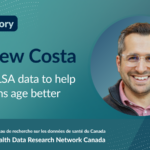How can linked data help improve the way we understand aging?


Canada’s aging population has long been a cause for concern among health researchers and policy makers. With the number of Canadians aged 75 and up expected to double over the next 13 years, experts warn that Canada’s health care system isn’t prepared to meet the needs of this growing demographic. “In light of these population changes, making linked administrative data on aging available to researchers is critical for informing evidence-based decision making that will lead to better health for older adults,” explained Andrew Costa, Associate Scientific Director of the Canadian Longitudinal Study on Aging (CLSA), an HDRN Canada partner.
This year, HDRN Canada and CLSA announced that researchers can now access linked cohort data from CLSA at provincial data centres in British Columbia, Ontario and New Brunswick. With agreements in additional provinces underway, the announcement represented a significant milestone in a multi-year collaborative initiative between CLSA and HDRN Canada, whose pan-Canadian membership includes provincial data centres. The announcement was a cause for celebration in recognition of the huge opportunity it creates for researchers seeking to examine aging and health care utilization across Canada.
Making linked administrative data on aging available to researchers is critical for informing evidence-based decision making that will lead to better health for older adults. ~ Andrew Costa
Born out of the growing need to understand Canada’s aging population, CLSA is a long-term national study that follows approximately 50,000 individuals between the ages of 45 and 85 for at least 20 years. Set to conclude in 2033, the study enables interdisciplinary research on various aspects of aging, including biological, medical, psychological, social, lifestyle and economic factors. This data can be used for things like health services projections and improving understanding of biological markers of disease and major neurocognitive disorders.
Because the study doesn’t include much information on health services use, linking CLSA data with administrative health data held by HDRN Canada member organizations is key to creating a more robust picture of how Canada’s health care systems serve – or fail – its aging population. Linkage enables data collected by CLSA about an individual to be synched to data on the same individual from another source. This makes the data more useful to researchers interested in understanding how people interact with health care systems throughout their lives.
While more than 90 percent of CLSA participants have consented to data linkage, the process of linkage is complex. “Although CLSA has consent for linkage from participants, making it happen is very, very challenging.” HDRN Canada and CLSA are working to create data sharing agreements with provincial and territorial data centres that will allow them to host CLSA data and enable access to linked data for authorized researchers. “Collaborating with HDRN Canada was critical because going through the linkage process with data centres individually would have been a significant challenge,” he says.
Because the collaboration was first established during the pandemic, there were substantial delays, but strong commitment to getting linked data on aging in Canada into the hands of researchers ensured its success. “It needed to come together not only for better research on aging, but for the 50,000 participants who consented to having their data linked because they understood the benefit to the public in the long-run.”
To learn more about the data linkage collaboration between CLSA and HDRN Canada, watch Andrew Costa’s co-presentation with Lindsey Gilbert as part of HDRN Canada’s Discussion Sessions.
